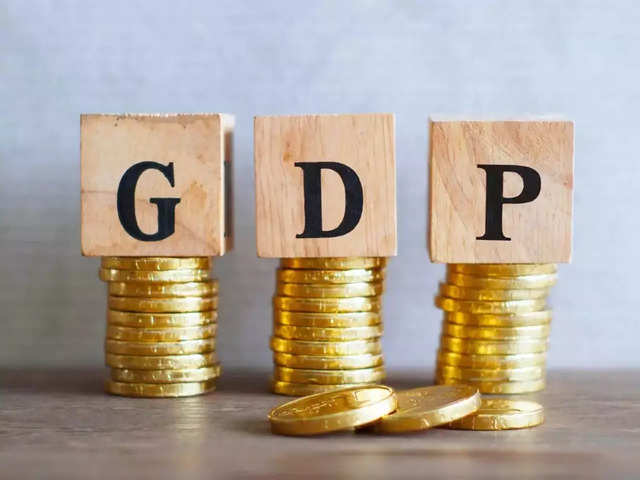What impact will a US recession have on India?

According to the International Monetary Fund (IMF), the world economy is facing a “broad-based and sharper-than-expected recession” with record-high inflation rates. Numerous economies, notably the US economy, have been experiencing a downturn for months. What the future holds for India is the burning issue that has economists split.
The new quarterly economic predictions that will be disclosed along with the policy statement might cause markets to get uneasy, even though investors generally anticipate the Fed to raise its policy rate by 75 basis points, to the range of 3.00%–3.25%.

Wall Street is concerned that the rate of increase might significantly limit economic growth and even trigger a recession. Data indicating that the US economy is already slowing down and company warnings about the effects of inflation and supply chain issues on their operations have increased these worries. Along with the US, Britain too experienced an economic recession. The Eurozone has not yet fully recovered from the epidemic, and China has recently slowed down due to repeated lockdowns in its major cities.
A slowdown is now being fought by both the US and China. In such a situation, it wouldn’t be incorrect to state that recession worries are more than justified when two of the world’s largest economies are experiencing such a dip. And if that occurs, spillover effects will undoubtedly also have an impact on India.
What is India’s position?
India recorded a 13.5% increase in its gross domestic product for the first quarter that ended on June 30, 2022 (GDP). Even while the figures appear to be adequate on the surface, they are 2.7 percentage points below what the Reserve Bank of India (RBI) anticipated. Therefore, many people were disappointed by the GDP figures. A more significant recovery was anticipated following the first quarter of last year when the first wave of COVID-19 severely hindered economic activity.
The figures display the quickest increase in a year. The last time India’s GDP had a significant increase was in Q1 of FY22, when it increased by 20.1%. In actuality, economic momentum has slowed, suggesting that GDP may slow down much more in the ensuing quarters. According to research by source Securities, India is not immune to a US recession, and even in typical Fed-led recessions, domestic GDP has slowed by 1.5 to 2.5%.
The research said, “We think that GDP growth might decline to 6% in FY24 (reduced from 7% earlier) assuming a mild US recession and GDP growth of 7.5% in FY23 in our base scenario.” It made the case that even a mild, brief recession in the US can lower GDP by using examples from prior statistics. The report continues by predicting that relatively stable domestic fundamentals, including strong balance sheets in the financial and non-financial sectors, high foreign exchange reserves, and some countercyclical fiscal policy implemented in advance of the FY24 elections, will keep the growth slowdown to 1.5%.
According to the analysis, assuming that the US experiences a moderate recession, the economic growth forecast for FY24 was further reduced from 7% to 6%.
Significant production drop in 2023
If the epidemic hadn’t occurred, global production would have increased by 23% since 2016. But as of right now, just 17% growth is predicted. Real GDP will remain below its pre-pandemic trend due to the global downturn, which is predicted to cost the globe more than $17 trillion, or about 20% of global revenue. According to a UNCTAD analysis, Russia, Indonesia, India, the United Kingdom, and Germany are among the nations that may be most responsible for this decline in global productivity.
While the production of India may decline by 7.8% in 2023, that of the Euro area is predicted to decline by 5.1%, that of China by 5.7%, that of the United Kingdom by 6.8%, and that of Russia by 12.6%. Uncertainty has been brought to the global markets as a result of rising interest rates, weakening currencies, expanding governmental debt, and other related issues that have raised food and gasoline costs.
An increase in interest rates to stop inflation
According to recent World Bank research, boosting interest rates by central banks throughout the world to combat inflation may not be the best course of action. The recession and other financial crises may result from this. “The rate of global growth is rapidly declining, and as more nations experience recession, this rate is expected to continue.” “My grave worry is that these trends will continue, with severe long-term effects for those living in emerging markets and developing countries,” said David Malpass, president of the World Bank Group.
A recession may also occur in 2019, according to the International Monetary Fund (IMF). This week, Kristalina Georgieva, MD of the IMF, predicted that until 2026, global economic growth may slow by $4 trillion. She said, “It’s more probable that things will become worse than better.” All areas are anticipated to be impacted, but alarms are sounding the loudest for emerging nations since several of them are on the verge of defaulting on their debt. Countries with lower incomes and lower middle incomes spend more money on debt servicing. The nations with the largest share of revenue needed to cover their national debt are Somalia, Sri Lanka, Angola, Gabon, and Laos.
Weakened currency values
Developing nations have used around $379 billion of their reserves to cushion declining currencies, nearly double the amount of new Special Drawing Rights (SDR) created by the IMF. An SDR’s value is determined by a basket of the five most valuable currencies in the world: the US dollar, the euro, the yuan, the yen, and the British pound. According to estimates, the most vulnerable people are being severely hurt by the advanced nations’ increases in interest rates. According to the UNCTAD, almost a third of the nearly 90 developing nations have had their currencies depreciate by more than 10% this year.
Expensive gasoline and food
The lives of regular people are directly impacted by two factors: food and energy. Prices for food and gasoline have dramatically increased in 2022. The Indian basket of crude oil prices averaged $102.14 per barrel from April to October 2022, while the food price index increased to a career-high of 125.7 in 2021 and further to 146.94 by September 2022. In 2021–2022, the price of the Indian crude oil basket was $79.18 per barrel, compared to $44.82 per barrel in the previous fiscal year.
What is the likely outcome?
Goods exports might decrease: The US, one of India’s main trading partners, had a market share of 18.1% of India’s goods exports in FY22. According to the research, India is thus susceptible to a US recession. India’s software exports are anticipated to suffer the most.
The study used historical data to demonstrate that the Federal Reserve has historically decreased interest rates in response to recessions or major slowdowns in the US economy. In contrast, the Fed has been raising rates aggressively since March 2022 to rein in inflation, which has risen to a 40-year high in the largest economy in the world.
Not just the US, but nearly all major economies across the world have seen inflation pressure since two important trade routes, led by Russia and Ukraine, had to be closed in the aftermath of the conflict. As a result, major commodities like crude oil saw their prices soar to all-time highs that countries had to pay much more per barrel. According to experts, the central bank’s ongoing rate increases have significantly impacted the downturn in GDP. Similar to India, central banks throughout the world were confronted with the choice of promoting growth or reducing inflation; the majority chose the latter.
To lower inflation, the Reserve Bank of India (RBI) also took coordinated action and increased benchmark lending rates. The RBI increased interest rates by 140 basis points from March to August, bringing them to the pre-pandemic level of 5.4%. The effect on inflation, however, has not yet been felt. As a result, it is anticipated that the Reserve Bank will choose to increase interest rates once more at its next meeting of the monetary policy committee (MPC).
The report also mentioned that India’s cycle of rate increases has never gone the opposite way as the Fed’s has. However, there have been long gaps in which the Fed raised as well as lowered rates, most notably in the 1970s and 1980s. Similar to this, the RBI kept a pause when the Fed lowered rates in the early 1990s. While the Fed maintained its pause between 2010 and 2014, the RBI increased rates over time. In the case of a US recession, the research stated, “there is a probability that the RBI might remain on a prolonged pause or not match the rate reduction (if any) by the Fed.” This would happen if India’s GDP remained reasonably durable.
edited and proofread by nikita sharma




